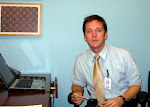What David Beckham and Ryan Phelps have in common - Recent media


Fitzhugh Mullan, M.D.
The free full NEJM article links below offer a nice overview of the human resource challenges facing today's Africa. The second article just came out. (Thank you, Gordon, for the email link.) Both are by the gentleman pictured above. I have included a miniturized abstract of both articles for those with slow modems or fast attention spans.
The Metrics of the Physician Brain Drain
Background: There has been substantial immigration of physicians to developed countries, much of it from lower-income countries. Although the recipient nations benefit, less developed countries lose important health capabilities as a result of the loss of physicians.
Methods: Data on the countries of origin of international medical graduates practicing in the U.S, the U.K., Canada, and Australia were obtained and analyzed.
Results: International medical graduates constitute between 23 and 28 percent of physicians in the United States, the United Kingdom, Canada, and Australia, and lower-income countries supply between 40 and 75 percent of these international medical graduates. Nine of the 20 countries with the highest emigration factors are in sub-Saharan Africa or the Caribbean.
Conclusions: Reliance on international medical graduates in the United States, the United Kingdom, Canada, and Australia is reducing the supply of physicians in many lower-income countries.
Doctors and Soccer Players – African Professionals on the Move Health statistics in many sub-Saharan African countries are sliding backward. Much of this is due to AIDS, but an exodus of doctors and nurses to the U.S. is leaving African AIDS patients without access to care.
In Ghana, for example, there are 13 physicians per 100,000 population (256 in the U.S.) and 92 nurses per 100,000 (937 in the U.S.). In the mean time, 532 Ghanaian doctors practice in the U.S. and 259 work in the U.K. and Canada. 2600 physicians remain in Ghana. The Ghana MOH has responded by training more physicians, nurses, and other practitioners, but the leak continues.
For 25 years, the number of U.S. allopathic medical students has remained the same while the physicians we import has climbed. By creating a huge U.S. market for physicians educated abroad, we have destabilized medical systems in countries that are battling poverty and epidemic disease. Soccer players may migrate to the elite leagues of the world, but if doctors and nurses stay closer to home, they will save lives.
Labels: Media


0 Comments:
Post a Comment
<< Home